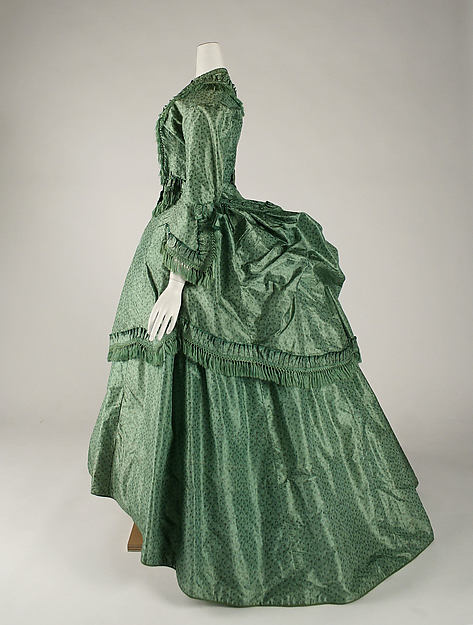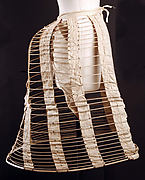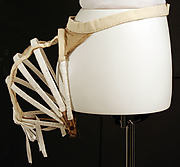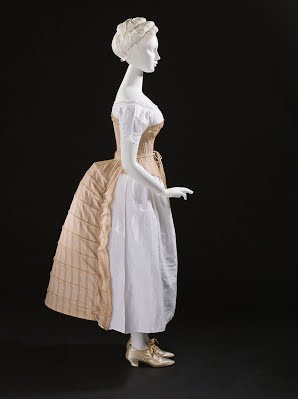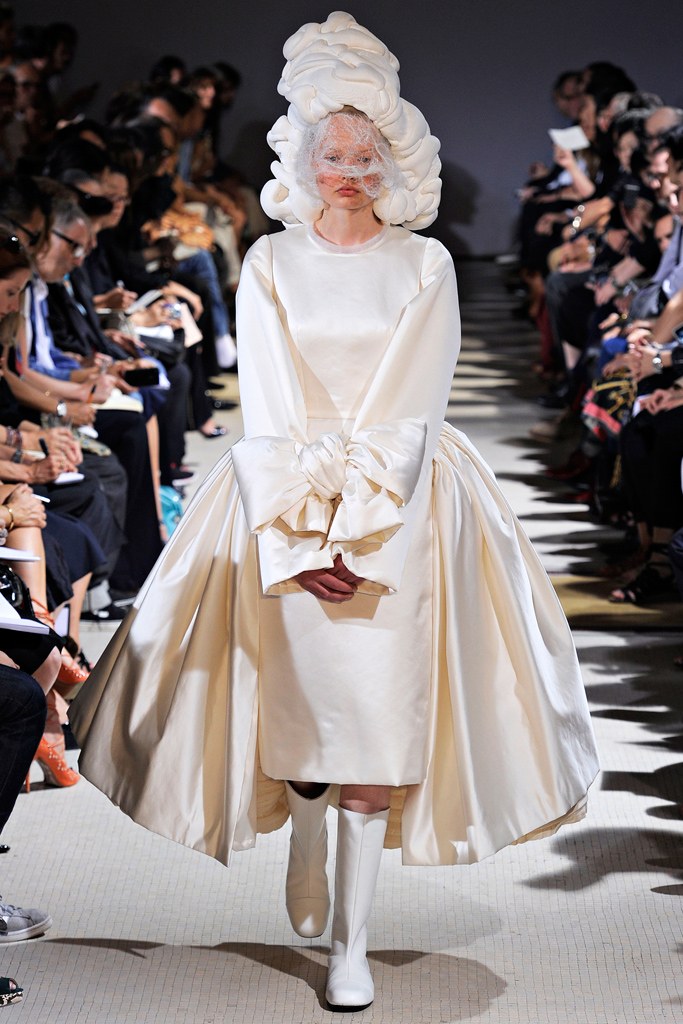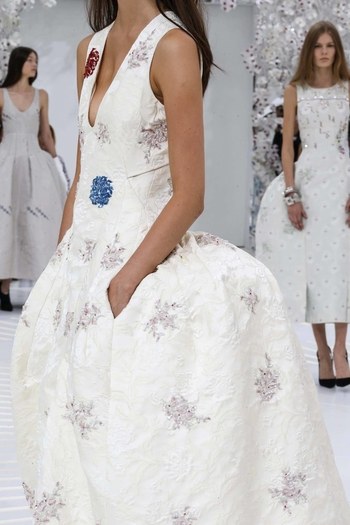A pad or frame worn under a skirt puffing it out behind.
The Details
Valerie Cumming, C.W. Cunnington, and P.E. Cunnington in The Dictionary of Fashion History (2010) write:
“The term “bustle” was not used until c.1830: this is now a usual description for a device for thrusting out the skirt at the back of the waist.” (34-35)
Phyllis Tortora and Sandra Keiser in The Fairchild Dictionary of Fashion (2014) write:
“Pad, cushion, or arrangement of steel springs creating a rounded projection below the waist at the back of woman’s dress.” (464)
According to the Encyclopedia of Clothing and Fashion (2004):
“Exaggeration of the feminine posterior has been a periodic theme in Western fashion for several hundred years. The pulled-back overskirts of late-seventeenth and early-eighteenth-century mantuas (loose-fitting gowns) emphasized this area, and pads or “cork rumps” sometimes supported the swagged-up styles of the late 1770s and 1780s. Even early-nineteenth-century neoclassical dresses often featured a small back pad—a socalled artificial hump—to give the high-waisted line a graceful flow. As waists lowered and skirts widened, the pad was retained, and by the late 1820s it was called a bustle.”
In the Encyclopedia of World Dress and Fashion (2010) the bustle is defined as:
“Until the early 1860s, the crinoline cage retained its domed shape, growing in circumference and inspiring many satirical cartoons. After this time, it started to flatten in front, and, from the late 1860s, bustle structures were used to hold skirts out at the back. The early 1870s saw the more general use of tournures (bustles). They were created using a wide variety of materials such as metal, cane, or whalebone hoops or woven horsehair flounces. Bustles disappeared after two to three years, only to return to fashion in a more exaggerated form from the early 1880s. They then grew in size to large horizontal protrusions. Some, such as the chimney bustle, were designed to collapse as the wearer sat down. “
Fig. 1 - Designer unknown (British). Dress, 1870. Silk. New York: The Metropolitan Museum of Art, 1980.409.1a–c. Catharine Breyer Van Bomel Foundation Fund, 1980. Source: The Metropolitan Museum of Art
Fig. 2 - Designer unknown (American). Woman's dress Ensemble, ca. 1870. Silk taffeta, linen plain weave, and cotton twill weave with silk macramé fringe; 123.19 cm (48 1/2 in, center back). Los Angeles: Los Angeles County Museum of Art, M.2007.211.773a-d. Source: Los Angeles County Museum of Art
Fig. 3 - Mme Grapanche (American). Dinner dress, 1884–86. Silk. New York: The Metropolitan Museum of Art, C.I.63.23.3a, b. Gift of Mrs. J. Randall Creel, 1963. Source: The Metropolitan Museum of Art
Fig. 4 - Maker unknown (American). Bustle, 1870s. New York: The Metropolitan Museum of Art, C.I.45.79.2. Gift of Estate of Mary Le Boutillier, 1945. Source: The Metropolitan Museum of Art
Fig. 5 - Maker unknown (American). Bustle, ca. 1880. Wire, cotton. New York: The Metropolitan Museum of Art, C.I.51.26.7. Gift of Mr. Frank Carrington, 1951. Source: The Metropolitan Museum of Art
Fig. 6 - Maker unknown (American). Bustle, 1882. Steel, cotton. New York: The Metropolitan Museum of Art, C.I.53.72.19. Gift of Mrs. William R. Witherell, 1953. Source: The Metropolitan Museum of Art
Fig. 7 - Maker unknown (English). Woman's bustle, ca. 1885. Cotton twill, cotton-braid-covered steel, and cotton-braid cord; 78.74 cm (31, center back in). Los Angeles: Los Angeles County Museum of Art, M.2007.211.399. Source: Los Angeles County Museum of Art
Figure 1 and figure 2 show the silhouette of bustle dress with different embellishments in 1870. Figure 3 is an another example of the bustle dress in 1880s, showing a unique bustle detail at the back. Figure 4 to Figure 6 show the variety of bustle-style supports available between 1870s and 1880s. Figure 7 features a full bustle made in 1885.
Its Afterlife
Fig. 8 - Comme des Garçons (Rei Kawakubo) (Japanese). Ready to Wear Fashion Show, Spring 2012. Source: Vogue
Fig. 9 - Christian Dior (French). Couture Fashion Show, Fall 2014. Source: Vogue
References:
- “Bustle.” Wikipedia, September 28, 2017. https://en.wikipedia.org/w/index.php?title=Bustle&oldid=802763681.
-
Cumming, Valerie, C. Willett Cunnington, Phillis Cunnington, and Charles Relly Beard. The Dictinary of Fashion History. New York: Berg, 2010. http://www.worldcat.org/oclc/1002419232.
-
Eicher, Joanne Bubolz, ed. Encyclopedia of World Dress and Fashion. New York: Oxford University Press, 2010. http://www.worldcat.org/oclc/767923552.
- Haugland, H. Kristina. “Bustle.” Encyclopedia of Clothing and Fashion 1 (November 30, 2004): 204–6. http://libproxy.fitsuny.edu:2200/ps/i.do?p=GVRL&sw=w&issn=&v=2.1&it=r&id=GALE%7CCX3427500101&sid=googleScholar&linkaccess=abs
- Tortora, Phyllis G., Sandra J. Keiser, and Bina Abling. The Fairchild Books Dictionary of Fashion. 4th edition. New York: Fairchild Books, an imprint of Bloomsbury Publishing Inc, 2014. http://www.worldcat.org/oclc/900349357.


